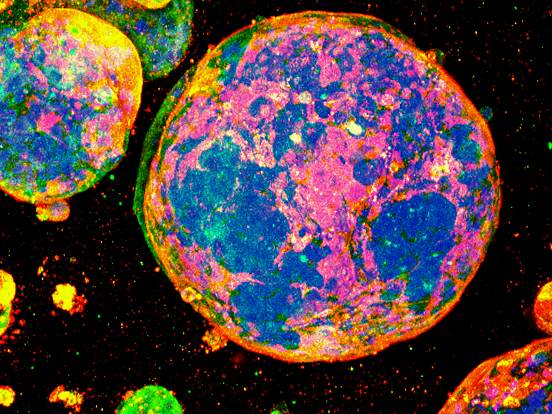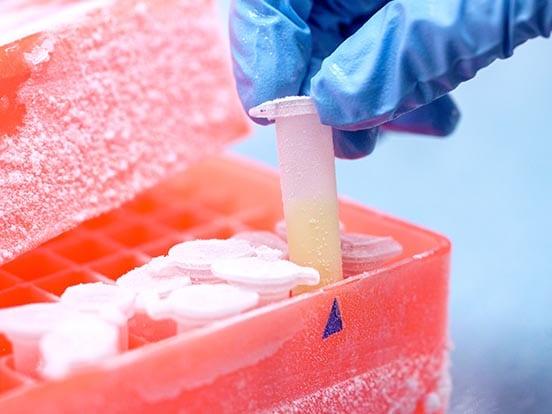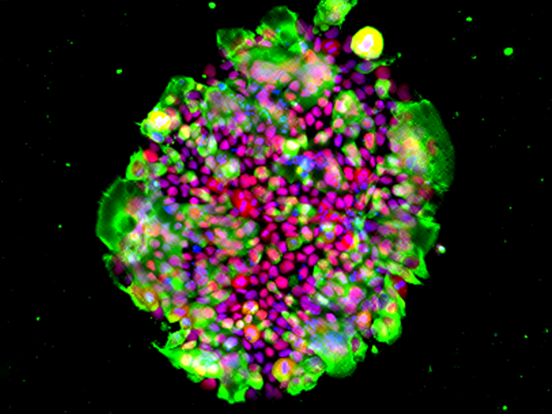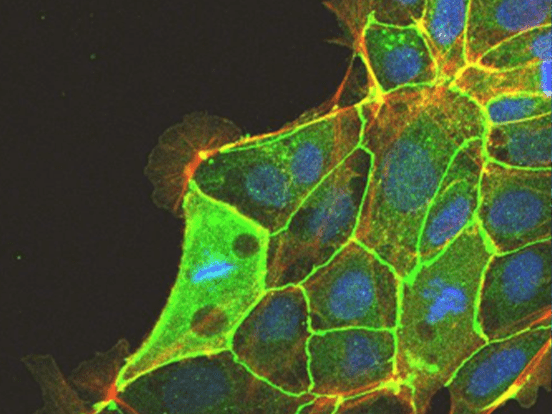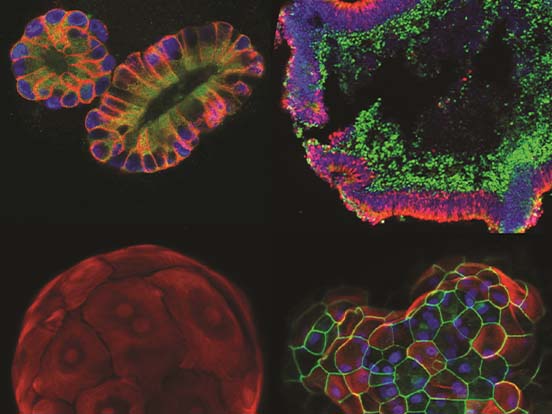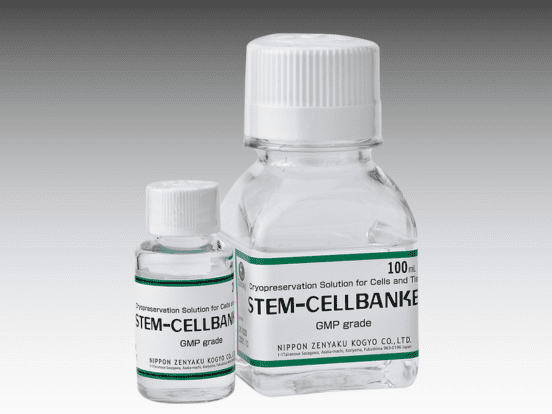Features
- Fully defined (combination of medical grade collagen + Laminin E8 fragment cross linked to hyaluronic acid with genipin)
- Regulatory friendly (medical grade collagen and laminin is available)
- Solution at 4C – becomes a clear gel when incubated at 37C
- Multi-organ organoid formation
- Suitable for Xenograft transplantation
Benefits
- High batch-to-batch reproducibility between vials
- Highly versatile (can be used with a variety of cells including iPSCs and ASCs)
- Cell culture of various organ tissues possible by adjusting collagen type and concentration, laminin isoform, and various ECM components
- Drug Screening that can be completed in vitro and is more representative of in vivo testing compared to Matrigel™
Matrix Composition
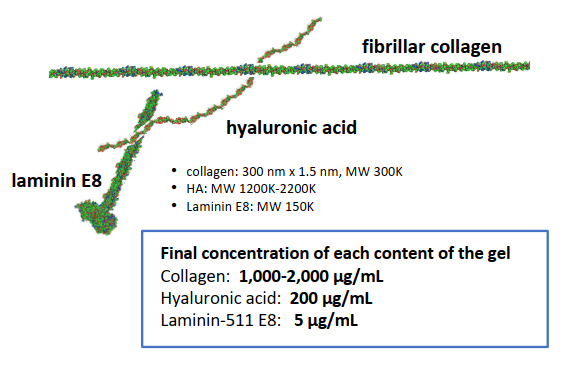
- Sodium hyaluronate (average MW 1,200-2,200 kDa, HA-LQH, made by fermentation method with Streptococcus zooepidemicus, Kewpie, Japan) is cross-linked with human recombinant laminin-511 E8 fragment using genipin.
- Matrimix builds on our iMatrix technology: the recombinant laminin C-terminal E8 fragment is about 1/5 of full-length laminin molecule. Laminin-511E8 has a strong interaction with cellular integrin α6β1 and induces cell motility.
- Pepsin-extracted porcine skin collagen (roughly 80-85% of type I and 15-20% type III collagens) and acid soluble bovine skin collagen was used.
- Type IV collagen was extracted from porcine kidney with pepsin.
- Type V collagen was extracted from porcine cornea.
Gel Culture Protocol

- Matrimix is a solution at 4°C
- Before culturing the three vials of MatriMix are mixed together
- The cells required are centrifuged to create a cell pellet
- Cells are then suspended in MatriMix and allowed to gel in a CO2 incubator set at 37°C for least 30 minutes
- See datasheet for full protocol
Product Information Table
| Name | Datasheet | Packsize | Order |
|---|---|---|---|
| MatriMix (511) | 3.6ml (solution A), 1.0ml (solution B), 3.0ml (Solution C) | View |
Application Spotlight
MatriMix can be used for a variety of 3D cell culture applications. It can induce multi-organ organoids formation, allows for excellent cell organization and provides a more in vivo mimetic in vitro model compared to current 3D substrates.
Induction of Organoid Formation
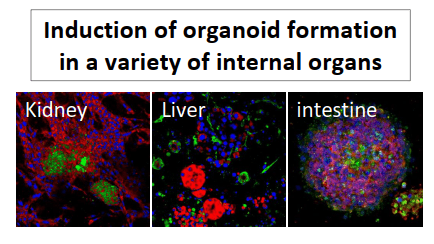
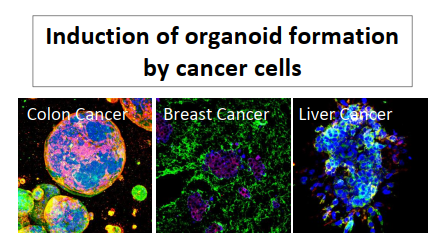
- MatriMix is able to induce organoid formation of a variety of different organ types including kidney, liver, intestine and many more.
- It provides a more "in vivo mimetic" in vitro model that solves various problems with the EHS tumor extracts.
- MatriMix is excellent for cultured cells that are difficult to grow and organise in the EHS tumor extracts.
- Drug screening can be performed in vitro without transplantation into a mouse model.
- Drugs can be screened for highly malignant cancers with metastatic potential.
Culture of Mouse Embryonic Kidney Cells
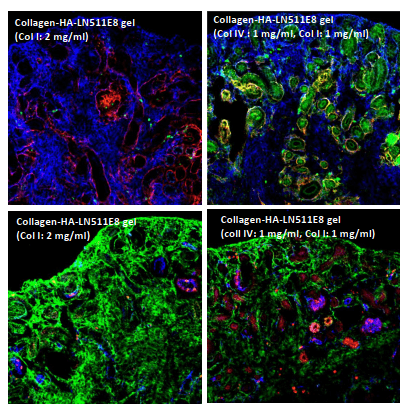
The effect of Type IV collagen on organoid culture of mouse embryonic kidney cells
Type IV Collagen was mixed to Type I Collagen.
Type IV collagen (green) Type I collagen (red) HA (blue)
The addition of type IV collagen enhanced differentiation into renal epithelial tissue as indicated by presence of Nephrin and PECAM1 markers.
MatriMix allows for excellent cell organisation of glomerulus-like structures.
In MatriMix type IV collagen is found to localise inside of the cell aggregate, so increased cell contact, whilst in Matrigel it localises on the outside of the cell aggregate.

Effect of Laminin E8 isoforms on Organoid Phenotype
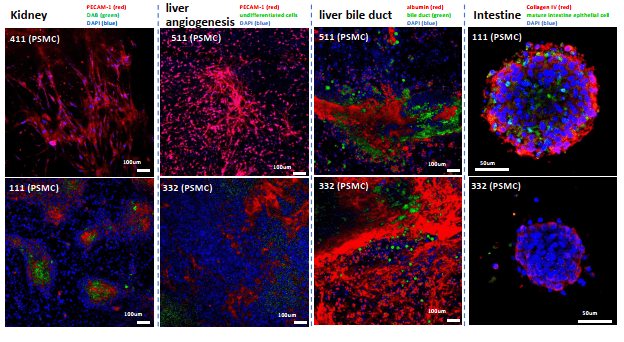
MatriMix was prepared by substituting laminin E8 for the other isoforms used in MatriMix and culture studies were performed.
After 7 days of culture, the cells were fixed, stained with each marker antibody, and observed for fluorescence.
In renal organoid formation, laminin- 111 induces renal glomerular (podocyte) differentiation (Podcalyxin: green), while PECAM-1 positive angiogenesis was induced in MatriMix with laminin-411.
In liver organoid formation, MatriMix 511 is superior in both vascular and bile duct induction; in MatriMix 332 there are fewer vessels and albumin-positive cells predominate.
In intestinal organoids, mature intestinal marker (CDX-2: green) positive cells are more abundant in MatriMix 111 cultures indicating that they induce more maturation.
Xenograft Transplantation of Cancer Spheroids
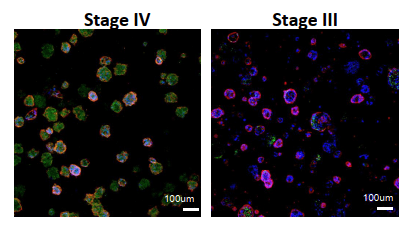
These patient derived cancer spheroids can successfully be transplanted into nude mice. This is particularly important for use in in vivo drug screening assays.
- In MatriMix gel, cells derived from patients with Stage 4 metastatic colon cancer showed a cell population positive for the metastatic potential marker ZEB-1.
- Cells derived from Stage 3 colon cancer patients without metastasis, ZEB-1 expression was suppressed.
ZEB-1 (green), E-cad (red), DAPI (blue)
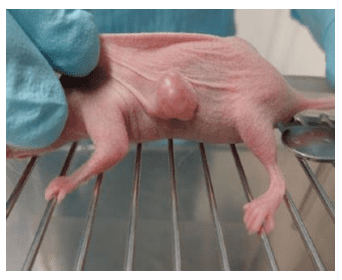
Frequently Asked Questions
Is MatriMix the same as mouse tumor-derived basement membrane components?
MatriMix is a three-dimensional culture substrate composed of collagen, laminin E8 fragments, and hyaluronic acid, which is different from mouse tumor-derived basement membrane components. MatriMix is a product developed with the aim of providing an extracellular environment suitable for various cells by changing the types, combinations, and concentrations of collagen and laminin E8 fragments.
What ingredients are in MatriMix?
MatriMix is mainly composed of collagen and hyaluronic acid cross-linked with human laminin E8 fragments. Others include DMEM, PBS and sodium bicarbonate.
What is the origin of the laminin E8 fragment?
A laminin fragment (E8 fragment) containing a sequence important for integrin binding activity is expressed as a recombinant protein in CHO-S cells and purified to a high degree of purity. This recombinant protein is sold as the iMatrix series.
How are hyaluronic acid and laminin E8 fragments crosslinked?
Genipin, which is said to have low cytotoxicity, is used for cross-linking. Hyaluronic acid is a sugar chain in which N-acetylglucosamine and D-glucuronic acid are linked in a straight chain. Genipin cross-links the amino group of glucosamine without an acetyl group and the amino group of lysine of laminin.
The type of collagen in MatriMix?
We sell various types of collagen derived from various animals. Please take a look at this for more information.
If you purchase our research reagent collagen, you can customize it by mixing it with the collagen (solution C) that comes with MatriMix. However, depending on the concentration and amount of collagen added, gelation may be affected, so please contact [email protected].
Are growth factors included?
This product does not contain any growth factors. Collagen, which is the main component, is derived from animal tissue, hyaluronic acid is derived from microorganisms, and laminin E8 is derived from CHO-S cell culture supernatant (completely synthetic medium/no animal-derived components), each of which is highly purified, which is thought to contain almost no growth factors.
Can it be used in cancer patient tissue/cell (PDX/PDC) transplant models?
We have confirmed that tumors are formed by transplanting cancer patient cells into mice using MatriMix. We are currently analyzing the details.
Is cryopreservation possible?
MatriMix cannot be frozen before and after mixing each solution. Since gelation is affected, it is recommended to be prepared at the time of use, and please store in the refrigerator before mixing each liquid.
For Cryopreservation of your Organoids, we offer CELLBANKER Cryopreservation media - available in several formulations, this series of easy-to-use cell freezing media offers high cell viability in serum, serum-free, GMP and DMSO-free formats.
The gel does not harden (gelation is slow).
It takes longer to gel than mouse tumor-derived basement membrane components. Gelation requires heating at 37°C for 30 minutes or more, and a slight cloudiness is a measure of gelation.
Since this product affects gelation, it cannot be frozen or stored after preparation. Please refrigerate and prepare as needed according to the instruction manual.
Diluting this product may make it difficult to gel. Especially in the case of embedding culture, remove as much medium as possible by centrifugation before suspending with cells. Cells tend to sink to the bottom of the culture vessel when gelation is difficult to occur.
Will the gel shrink during incubation?
If there are many stromal cells, the gel may shrink. It is thought that mesenchymal cells interact with type I collagen to bundle collagen fibers and contract the gel.
Embedding culture causes the cells to sink to the bottom of the culture vessel.
Depending on the type and size of the cells, the presence or absence of cell clumps, and the gel volume (height), it may sink before it gels. Countermeasures include (1) dropping the gel solution into a pre-warmed culture vessel and starting heating immediately, (2) switching to sandwich culture, and (3) changing the type and concentration of collagen.
Does the color change when you mix each liquid?
Solution A (concentrated DMEM, hyaluronic acid/laminin E8 crosslinked product) has a grayish blue color. The bluish color comes from the cross-linking reaction between hyaluronic acid and laminin E8.
Since the concentrated DMEM of solution A contains phenol red, it turns pink when mixed with solution B (sodium bicarbonate), and turns pale pink when mixed with solution C (collagen).
After mixing the 3 liquids, the pH may rise and the pink color may become darker over time. Please use immediately after preparation.
